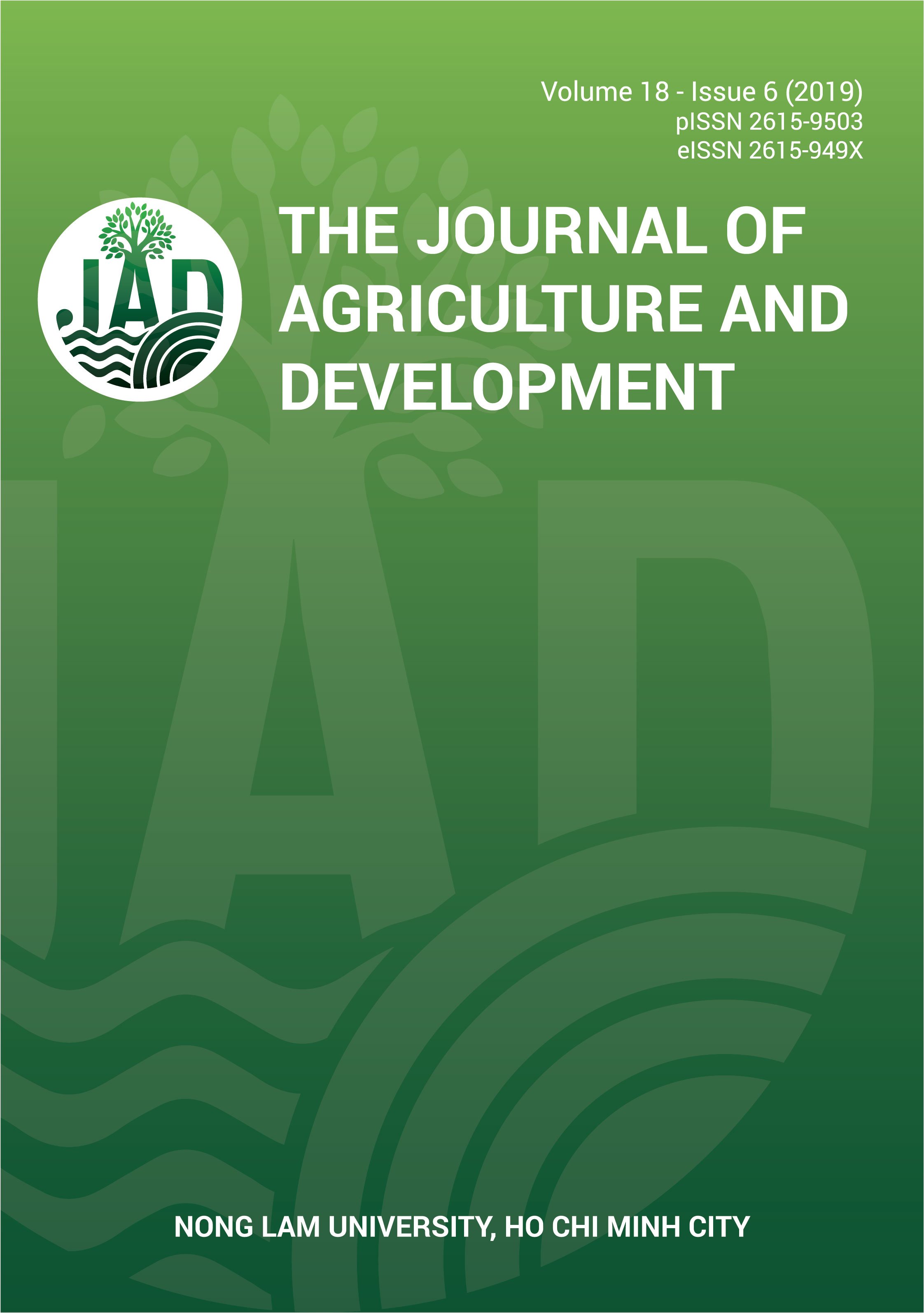Multiplex RT-PCR assay to differentiate genotypes of porcine reproductive and respiratory syndrome virus in swine
Main Article Content
Abstract
Porcine reproductive and respiratory syndrome (PRRS) is one of the most economically important diseases to swine industry worldwide. Due to the heterogeneity of field isolates, accurate detection of the PRRS virus is a diagnostic challenge. Recently, coinfection with NA-PRRSV, EU-PRRSV and HP-PRRSV isolates continuously increases in many countries, resulting in a significant impact on PRRSV diagnostics and disease control on farms. To facilitate rapid diagnosis and reliable discrimination of NA-PRRSV, EU-PRRSV and HP-PRRSV, a multiplex RT-PCR assay was established with three pairs of primers targeting highly conservative regions of nsp2 gene with predicted multiplex RT-PCR products of 364 bp, 161 bp and 259 bp, respectively. The primer pairs were optimized to be highly specific for PRRSV genotypes and were able to detect the target gene at the limit of 102 copies/uL for each gene. Clinical samples were used to evaluate this multiplex RT-PCR in parallel with a commercial real-time RT-PCR kit. Results showed over 95.2% (20/21 samples) agreement between the mRT-PCR and the real-time RT-PCR kit. Hence, it indicated that this multiplex RT-PCR could be useful for rapid and differential diagnosis of NA-PRRSV, EU-PRRSV and HP-PRRSV in swine farms.
Article Details
References
Balka, G., Hornyak, A., Balint, A., Benyeda, Z., & Rusvai, M. (2009). Development of a one-step real-time quantitative PCR assay based on primer-probe energy transfer for the detection of porcine reproductive and respiratory syndrome virus. Journal of Virological Methods 158(1-2), 41-45. https://doi.org/10.1016/j.jviromet.2009.01.014
Cavanagh, D. (1997). Nidovirales: A new order comprising Coronaviridae and Arteriviridae. Archives of Virology 142(3), 629-633.
Das, P. B., Dinh, P. X., Ansari, I. H., de Lima, M., Osorio, F. A., & Pattnaik, A. K. (2010). The minor envelope glycoproteins GP2a and GP4 of porcine reproductive and respiratory syndrome virus interact with the receptor CD163. Journal of Virology 84(4), 1731-1740. https://doi.org/10.1128/JVI.01774-09
Das, P. B., Vu, H. L. X., Dinh, P. X., Cooney, J. L., Kwon, B., Osorio, F. A., & Pattnaik, A. K. (2011). Glycosylation of minor envelope glycoproteins of porcine reproductive and respiratory syndrome virus in infectious virus recovery, receptor interaction, and immune response. Virology 410(2), 385-394. https://doi.org/10.1016/j.virol.2010.12.002
Green, M. R., & Sambrook J. (2012). Molecular cloning: A laboratory manual - Volume 1 (4th ed.). New York, USA: Cold Spring Harbor Laboratory Press.
Johnson, C. R., Griggs, T. F., Gnanandarajah, J., & Murtaugh, M. P. (2011). Novel structural protein in porcine reproductive and respiratory syndrome virus encoded by an alternative ORF5 present in all arteriviruses. Journal of General Virology 92(5), 1107-1116. https://doi.org/10.1099/vir.0.030213-0
Kappes, M. A., & Faaberg, K. S. (2015). PRRSV structure, replication and recombination: Origin of phenotype and genotype diversity. Virology 479-480, 475- 486. https://doi.org/10.1016/j.virol.2015.02.012
Meng, X. J., Paul, P. S., Halbur, P. G., & Lum, M. A. (1995). Phylogenetic analyses of the putative M (ORF6) and N (ORF 7) genes of porcine reproductive and respiratory syndrome virus (PRRSV): Implication for the existence of two genotypes of PRRSV in the U.S.A. and Europe. Archives of Virology 140(4), 745-755. https://doi.org/10.1007/BF01309962
Mengeling, W. L., & Lager, K. M. (2000). A brief review of procedures and potential problems associated with the diagnosis of porcine reproductive and respiratory syndrome. Veterinary Research 31(1), 61-69.
https://doi.org/10.1051/vetres:2000057
Nelsen, C. J., Murtaugh, M. P., & Faaberg, K. S. (1999). Porcine reproductive and respiratory syndrome virus comparison: Divergent evolution on two continents. Journal of Virology 73(1), 270-280. https://doi.org/10.1128/JVI.73.1.270-280.1999
Rossow, K. D., Bautista, E. M., Goyal, S. M., Molitor, T. W., Murtaugh, M. P., Morrison, R. B., Benfield, D. A., & Collins, J. E. (1994). Experimental porcine reproductive and respiratory syndrome virus infection in one-, four-, and 10-week-old pigs. Journal of Veterinary Diagnostic Investigation 6(1), 3-12. https://doi.org/10.1177/104063879400600102
Terpstra, C., Wensvoort, G., & Pol, J. M. A. (1991). Experimental reproduction of porcine epidemic abortion and respiratory syndrome (mystery swine disease) by infection with Lelystad vims: Koch’s postulates full-filled. Veterinary Quarterly 13(3), 131-136. https://doi.org/10.1080/01652176.1991.9694297
Tian, K., Yu, X., Zhao, T., Feng, Y., Cao, Z., Wang, C., Hu, Y., Chen, X., Hu, D., Tian, X., Liu, D., Zhang, S., Deng, X., Ding, Y., Yang, L., Zhang, Y., Xiao, H., Qiao, M., Wang, B., Hou, L., Wang, X., Yang, X., Kang, L., Sun, M., Jin, P., Wang, S., Kitamura, Y., Yan, J., & Gao, G. F. (2007). Emergence of fatal PRRSV variants: Unparalleled outbreaks of atypical PRRS in China and molecular dissection of the unique hallmark. PLoS One 2(6), e526. https://doi.org/10.1371/journal.pone.0000526
Xiao, S., Chen, Y., Wang, L., Gao, J., Mo, D., He, Z., & Liu, X. (2014). Simultaneous detection and differentiation of highly virulent and classical Chinese-type isolation of PRRSV by real-time RT-PCR. Journal of Immunology Research 2014, 1-7. https://doi.org/10.1155/2014/809656
Wernike, K., Hoffmann, B., Dauber, M., Lange, E., Schirrmeier, H., & Beer, M. (2012). Detection and typing of highly pathogenic porcine reproductive and respiratory syndrome virus by multiplex real-time RT- PCR. PLos One 7(6), e38251. https://doi.org/10.1371/journal.pone.0038251








